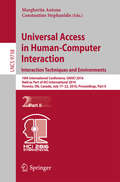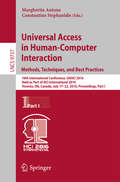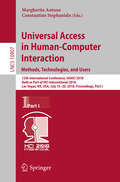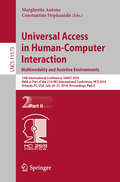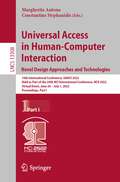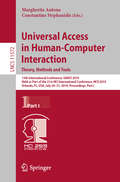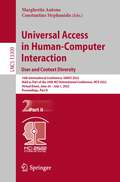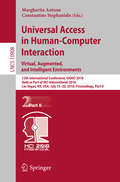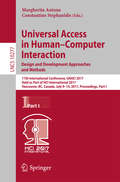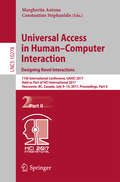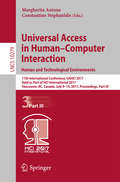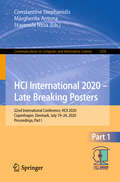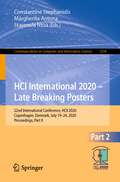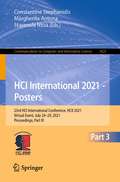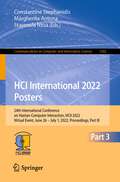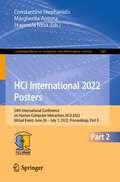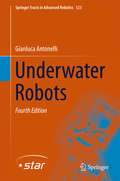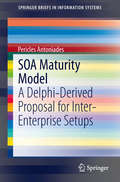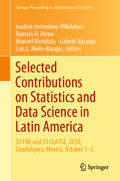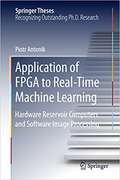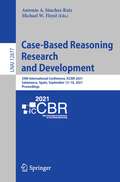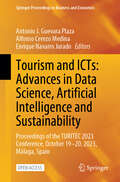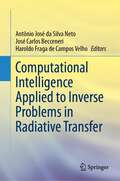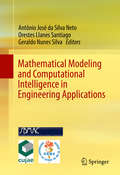- Table View
- List View
Universal Access in Human-Computer Interaction. Interaction Techniques and Environments
by Margherita Antona Constantine StephanidisThe three-volume set LNCS 9737-9739 constitutes the refereed proceedings of the 10th International Conference on Universal Access in Human-Computer Interaction, UAHCI 2016, held as part of the 10th International Conference on Human-Computer Interaction, HCII 2016, in Toronto, ON, Canada in July 2016, jointly with 15 other thematically similar conferences. The total of 1287 papers presented at the HCII 2016 conferences were carefully reviewed and selected from 4354 submissions. The papers included in the three UAHCI 2016 volumes address the following major topics: novel approaches to accessibility; design for all and eInclusion best practices; universal access in architecture and product design; personal and collective informatics in universal access; eye-tracking in universal access; multimodal and natural interaction for universal access; universal access to mobile interaction; virtual reality, 3D and universal access; intelligent and assistive environments; universal access to education and learning; technologies for ASD and cognitive disabilities; design for healthy aging and rehabilitation; universal access to media and games; and universal access to mobility and automotive.
Universal Access in Human-Computer Interaction. Methods, Techniques, and Best Practices
by Margherita Antona Constantine StephanidisThe three-volume set LNCS 9737-9739 constitutes the refereed proceedings of the 10th International Conference on Universal Access in Human-Computer Interaction, UAHCI 2016, held as part of the 10th International Conference on Human-Computer Interaction, HCII 2016, in Toronto, ON, Canada in July 2016, jointly with 15 other thematically similar conferences. The total of 1287 papers presented at the HCII 2016 conferences were carefully reviewed and selected from 4354 submissions. The papers included in the three UAHCI 2016 volumes address the following major topics: novel approaches to accessibility; design for all and eInclusion best practices; universal access in architecture and product design; personal and collective informatics in universal access; eye-tracking in universal access; multimodal and natural interaction for universal access; universal access to mobile interaction; virtual reality, 3D and universal access; intelligent and assistive environments; universal access to education and learning; technologies for ASD and cognitive disabilities; design for healthy aging and rehabilitation; universal access to media and games; and universal access to mobility and automotive.
Universal Access in Human-Computer Interaction. Methods, Technologies, and Users: 12th International Conference, UAHCI 2018, Held as Part of HCI International 2018, Las Vegas, NV, USA, July 15-20, 2018, Proceedings, Part I (Lecture Notes in Computer Science #10907)
by Margherita Antona Constantine StephanidisThis two-volume set LNCS 10907 and 10908 constitutes the refereed proceedings of the 12th International Conference on Universal Access in Human-Computer Interaction, UAHCI 2018, held as part of HCI International 2018 in Las Vegas, NV, USA, in July 2018.The total of 1170 papers and 195 posters included in the 30 HCII 2018 proceedings volumes was carefully reviewed and selected from 4373 submissions.The 49 papers presented in this volume were organized in topical sections named: design for all, accessibility and usability; alternative I/O techniques, multimodality and adaptation; non-visual interaction; and designing for cognitive disabilities.
Universal Access in Human-Computer Interaction. Multimodality and Assistive Environments: 13th International Conference, UAHCI 2019, Held as Part of the 21st HCI International Conference, HCII 2019, Orlando, FL, USA, July 26–31, 2019, Proceedings, Part II (Lecture Notes in Computer Science #11573)
by Margherita Antona Constantine StephanidisThis two-volume set constitutes the proceedings of the 13th International Conference on Universal Access in Human-Computer Interaction, UAHCI 2019, held as part of the 21st International Conference, HCI International 2019, which took place in Orlando, FL, USA, in July 2019.The total of 1274 papers and 209 posters included in the 35 HCII 2019 proceedings volumes was carefully reviewed and selected from 5029 submissions.UAHCI 2019 includes a total of 95 regular papers; they were organized in topical sections named: universal access theory, methods and tools; novel approaches to accessibility; universal access to learning and education; virtual and augmented reality in universal access; cognitive and learning disabilities; multimodal interaction; and assistive environments.
Universal Access in Human-Computer Interaction. Novel Design Approaches and Technologies: 16th International Conference, UAHCI 2022, Held as Part of the 24th HCI International Conference, HCII 2022, Virtual Event, June 26 – July 1, 2022, Proceedings, Part I (Lecture Notes in Computer Science #13308)
by Margherita Antona Constantine StephanidisThis two-volume set constitutes the refereed proceedings of the 16th International Conference on Universal Access in Human-Computer Interaction, UAHCI 2022, held as part of the 24th International Conference, HCI International 2022, held as a virtual event, in June-July 2022. A total of 1271 papers and 275 posters included in the 39 HCII 2022 proceedings volumes. UAHCI 2022 includes a total of 73 papers; they focus on topics related to universal access methods, techniques and practices, studies on accessibility, design for all, usability, UX and technology acceptance, emotion and behavior recognition for universal access, accessible media, access to learning and education, as well universal access to virtual and intelligent assistive environments.
Universal Access in Human-Computer Interaction. Theory, Methods and Tools: 13th International Conference, UAHCI 2019, Held as Part of the 21st HCI International Conference, HCII 2019, Orlando, FL, USA, July 26–31, 2019, Proceedings, Part I (Lecture Notes in Computer Science #11572)
by Margherita Antona Constantine StephanidisThis two-volume set constitutes the proceedings of the 13th International Conference on Universal Access in Human-Computer Interaction, UAHCI 2019, held as part of the 21st International Conference, HCI International 2019, which took place in Orlando, FL, USA, in July 2019. The total of 1274 papers and 209 posters included in the 35 HCII 2019 proceedings volumes was carefully reviewed and selected from 5029 submissions. UAHCI 2019 includes a total of 95 regular papers; they were organized in topical sections named: universal access theory, methods and tools; novel approaches to accessibility; universal access to learning and education; virtual and augmented reality in universal access; cognitive and learning disabilities; multimodal interaction; and assistive environments.
Universal Access in Human-Computer Interaction. User and Context Diversity: 16th International Conference, UAHCI 2022, Held as Part of the 24th HCI International Conference, HCII 2022, Virtual Event, June 26 – July 1, 2022, Proceedings, Part II (Lecture Notes in Computer Science #13309)
by Margherita Antona Constantine StephanidisThis two-volume set constitutes the refereed proceedings of the 16th International Conference on Universal Access in Human-Computer Interaction, UAHCI 2022, held as part of the 24th International Conference, HCI International 2022, held as a virtual event, in June-July 2022. A total of 1271 papers and 275 posters included in the 39 HCII 2022 proceedings volumes. UAHCI 2022 includes a total of 73 papers; they focus on topics related to universal access methods, techniques and practices, studies on accessibility, design for all, usability, UX and technology acceptance, emotion and behavior recognition for universal access, accessible media, access to learning and education, as well universal access to virtual and intelligent assistive environments.
Universal Access in Human-Computer Interaction. Virtual, Augmented, and Intelligent Environments: 12th International Conference, UAHCI 2018, Held as Part of HCI International 2018, Las Vegas, NV, USA, July 15-20, 2018, Proceedings, Part II (Lecture Notes in Computer Science #10908)
by Margherita Antona Constantine StephanidisThis two-volume set LNCS 10907 and 10908 constitutes the refereed proceedings of the 12th International Conference on Universal Access in Human-Computer Interaction, UAHCI 2018, held as part of HCI International 2018 in Las Vegas, NV, USA, in July 2018.The total of 1170 papers and 195 posters included in the 30 HCII 2018 proceedings volumes was carefully reviewed and selected from 4373 submissions.The 48 papers presented in this volume were organized in topical sections named: virtual and augmented reality for universal access; intelligent assistive environments; and access to the web, social media, education, culture and social innovation.
Universal Access in Human–Computer Interaction. Design and Development Approaches and Methods
by Margherita Antona Constantine StephanidisThe three-volume set LNCS 10277-10279 constitutes the refereed proceedings of the11th International Conference on Universal Access in Human-Computer Interaction, UAHCI 2017, held as part of the 19th International Conference on Human-Computer Interaction, HCII 2017, in Vancouver, BC, Canada in July 2017, jointly with 14 other thematically similar conferences. The total of 1228 papers presented at the HCII 2017 conferences were carefully reviewed and selected from 4340 submissions. The papers included in the three UAHCI 2017 volumes address the following major topics: Design for All Methods and Practice; Accessibility and Usability Guidelines and Evaluation; User and Context Modelling and Monitoring and Interaction Adaptation; Design for Children; Sign Language Processing; Universal Access to Virtual and Augmented Reality; Non Visual and Tactile Interaction; Gesture and Gaze-Based Interaction; Universal Access to Health and Rehabilitation; Universal Access to Education and Learning; Universal Access to Mobility; Universal Access to Information and Media; and Design for Quality of Life Technologies.
Universal Access in Human–Computer Interaction. Designing Novel Interactions
by Margherita Antona Constantine StephanidisThe three-volume set LNCS 10277-10279 constitutes the refereed proceedings of the11th International Conference on Universal Access in Human-Computer Interaction, UAHCI 2017, held as part of the 19th International Conference on Human-Computer Interaction, HCII 2017, in Vancouver, BC, Canada in July 2017, jointly with 14 other thematically similar conferences. The total of 1228 papers presented at the HCII 2017 conferences were carefully reviewed and selected from 4340 submissions. The papers included in the three UAHCI 2017 volumes address the following major topics: Design for All Methods and Practice; Accessibility and Usability Guidelines and Evaluation; User and Context Modelling and Monitoring and Interaction Adaptation; Design for Children; Sign Language Processing; Universal Access to Virtual and Augmented Reality; Non Visual and Tactile Interaction; Gesture and Gaze-Based Interaction; Universal Access to Health and Rehabilitation; Universal Access to Education and Learning; Universal Access to Mobility; Universal Access to Information and Media; and Design for Quality of Life Technologies.
Universal Access in Human–Computer Interaction. Human and Technological Environments
by Margherita Antona Constantine StephanidisThe three-volume set LNCS 10277-10279 constitutes the refereed proceedings of the11th International Conference on Universal Access in Human-Computer Interaction, UAHCI 2017, held as part of the 19th International Conference on Human-Computer Interaction, HCII 2017, in Vancouver, BC, Canada in July 2017, jointly with 14 other thematically similar conferences. The total of 1228 papers presented at the HCII 2017 conferences were carefully reviewed and selected from 4340 submissions. The papers included in the three UAHCI 2017 volumes address the following major topics: Design for All Methods and Practice; Accessibility and Usability Guidelines and Evaluation; User and Context Modelling and Monitoring and Interaction Adaptation; Design for Children; Sign Language Processing; Universal Access to Virtual and Augmented Reality; Non Visual and Tactile Interaction; Gesture and Gaze-Based Interaction; Universal Access to Health and Rehabilitation; Universal Access to Education and Learning; Universal Access to Mobility; Universal Access to Information and Media; and Design for Quality of Life Technologies.
HCI International 2020 – Late Breaking Posters: 22nd International Conference, HCII 2020, Copenhagen, Denmark, July 19–24, 2020, Proceedings, Part I (Communications in Computer and Information Science #1293)
by Margherita Antona Constantine Stephanidis Stavroula NtoaThis book constitutes the poster papers presented during the 22nd International Conference on Human-Computer Interaction, HCII 2020, which was held in July 2020. The conference was planned to take place in Copenhagen, Denmark, but had to change to a virtual conference mode due to the COVID-19 pandemic.From a total of 6326 submissions, a total of 1439 papers and 238 posters have been accepted for publication in the HCII 2020 proceedings before the conference took place. In addition, a total of 333 papers and 144 posters are included in the volumes of the proceedings published after the conference as “Late Breaking Work” (papers and posters). These contributions address the latest research and development efforts in the field and highlight the human aspects of design and use of computing systems.The 62 papers presented in this volume are organized in topical sections as follows: HCI theory, methods and tools; mobile and multimodal interaction; interacting with data, information and knowledge; interaction and intelligence; user experience, emotions and psychophysiological computing.
HCI International 2020 – Late Breaking Posters: 22nd International Conference, HCII 2020, Copenhagen, Denmark, July 19–24, 2020, Proceedings, Part II (Communications in Computer and Information Science #1294)
by Margherita Antona Constantine Stephanidis Stavroula NtoaThis book constitutes the extended abstracts of the posters presented during the 22nd International Conference on Human-Computer Interaction, HCII 2020, which was held in July 2020. The conference was planned to take place in Copenhagen, Denmark, but had to change to a virtual conference mode due to the COVID-19 pandemic.From a total of 6326 submissions, a total of 1439 papers and 238 posters have been accepted for publication in the HCII 2020 proceedings before the conference took place. In addition, a total of 333 papers and 144 posters are included in the volumes of the proceedings published after the conference as “Late Breaking Work” (papers and posters). These contributions address the latest research and development efforts in the field and highlight the human aspects of design and use of computing systems.The 82 papers presented in this volume are organized in topical sections as follows: design for all and sssisitive technologies; virtual, augmented and mixed reality; learning; HCI, culture and art; health and wellbeing applications; HCI in mobility, automotive and aviation.
HCI International 2021 - Posters: 23rd HCI International Conference, HCII 2021, Virtual Event, July 24–29, 2021, Proceedings, Part III (Communications in Computer and Information Science #1421)
by Margherita Antona Constantine Stephanidis Stavroula NtoaThe three-volume set CCIS 1419, CCIS 1420, and CCIS 1421 contains the extended abstracts of the posters presented during the 23rd International Conference on Human-Computer Interaction, HCII 2021, which was held virtually in July 2021. HCII 2021 received a total of 6326 submissions, of which 1439 papers and 238 posters were accepted for publication in the pre-conference proceedings after a careful reviewing process.The 238 poster papers presented in these three volumes are organized in topical sections as follows: Part I: HCI theory and methods; perceptual, cognitive and psychophisiological aspects of interaction; designing for children; designing for older people; design case studies; dimensions of user experience; information, language, culture and media. Part II: interaction methods and techniques; eye-tracking and facial expressions recognition; human-robot interaction; virtual, augmented and mixed reality; sand privacy issues in HCI; AI and machine learning in HCI. Part III: interacting and learning; interacting and playing; interacting and driving; digital wellbeing, eHealth and mHealth; interacting and shopping; HCI, safety and sustainability; HCI in the time of pandemic.
HCI International 2022 Posters: 24th International Conference on Human-Computer Interaction, HCII 2022, Virtual Event, June 26 – July 1, 2022, Proceedings, Part III (Communications in Computer and Information Science #1582)
by Margherita Antona Constantine Stephanidis Stavroula NtoaThe four-volume set CCIS 1580, CCIS 1581, CCIS 1582, and CCIS 1583 contains the extended abstracts of the posters presented during the 24th International Conference on Human-Computer Interaction, HCII 2022, which was held virtually in June - July 2022. The total of 1276 papers and 275 posters included in the 40 HCII 2021 proceedings volumes was carefully reviewed and selected from 5583 submissions.The posters presented in these four volumes are organized in topical sections as follows: Part I: user experience design and evaluation; visual design and visualization; data, information and knowledge; interacting with AI; universal access, accessibility and design for aging. Part II: multimodal and natural interaction; perception, cognition, emotion and psychophysiological monitoring; human motion modelling and monitoring; IoT and intelligent living environments. Part III: learning technologies; HCI, cultural heritage and art; eGovernment and eBusiness; digital commerce and the customer experience; social media and the metaverse. Part IV: virtual and augmented reality; autonomous vehicles and urban mobility; product and robot design; HCI and wellbeing; HCI and cybersecurity.
HCI International 2022 Posters: 24th International Conference on Human-Computer Interaction, HCII 2022, Virtual Event, June 26 – July 1, 2022, Proceedings, Part II (Communications in Computer and Information Science #1581)
by Margherita Antona Constantine Stephanidis Stavroula NtoaThe four-volume set CCIS 1580, CCIS 1581, CCIS 1582, and CCIS 1583 contains the extended abstracts of the posters presented during the 24th International Conference on Human-Computer Interaction, HCII 2022, which was held virtually in June - July 2022. The total of 1276 papers and 275 posters included in the 40 HCII 2021 proceedings volumes was carefully reviewed and selected from 5583 submissions.The posters presented in these four volumes are organized in topical sections as follows: Part I: user experience design and evaluation; visual design and visualization; data, information and knowledge; interacting with AI; universal access, accessibility and design for aging. Part II: multimodal and natural interaction; perception, cognition, emotion and psychophysiological monitoring; human motion modelling and monitoring; IoT and intelligent living environments. Part III: learning technologies; HCI, cultural heritage and art; eGovernment and eBusiness; digital commerce and the customer experience; social media and the metaverse. Part IV: virtual and augmented reality; autonomous vehicles and urban mobility; product and robot design; HCI and wellbeing; HCI and cybersecurity.
Underwater Robots: Motion And Force Control Of Vehicle-manipulator Systems (Springer Tracts In Advanced Robotics #96)
by Gianluca AntonelliA classic in underwater robotics. One of the first volumes in the “Springer Tracts in Advanced Robotics” series, it has been a bestseller through the previous three editions. Fifteen years after the publication of the first edition, the fourth edition comes to print. The book addresses the main control aspects in underwater manipulation tasks. With respect to the third edition, it has been revised, extended and some concepts better clustered. The mathematical model with significant impact on the control strategy is discussed. The problem of controlling a 6-degrees-of-freedoms autonomous underwater vehicle is investigated and a survey of fault detection/tolerant strategies for unmanned underwater vehicles is provided. Inverse kinematics, dynamic and interaction control for underwater vehicle-manipulator systems are then discussed. The code used to generate most of the numerical simulations is made available and briefly discussed.
SOA Maturity Model
by Pericles AntoniadesCompanies have long sought to integrate existing Information Systems (IS) in order to support existing and potentially new business processes spread throughout their "territories" and possibly to collaborating organizations. A variety of designs can be used to this end, ranging from rigid point-to-point electronic data interchange (EDI) interactions to "Web auctions". By updating older technologies, such as "Internet-enabling" EDI-based systems, companies can make their IT systems available to internal or external customers; but the resulting systems have not proven to be flexible enough to meet business demands. A more flexible, standardized architecture is required to better support the connection of various applications and the sharing of data. Service-Oriented Architecture (SOA) is one such architecture. It unifies ("orchestrates") business processes by structuring large applications as an ad-hoc collection of smaller modules called "Services". These applications can be used by different groups of people both inside and outside the company, and new applications built from a mix of services (located in a global repository) exhibit greater agility and uniformity. Thus, SOA is a design framework for realizing rapid and low-cost system development and improving total system quality. SOA uses the Web Services standards and technologies and is rapidly becoming a standard approach for enterprise information systems integration. SOA adoption by enterprises has been identified as one of the highest business priorities by a recent Gartner study (Gartner 2007) and enterprises increasingly recognize the requirement for an increased "Service-orientation" and relevant comprehensive frameworks, which will not only help them position themselves and evaluate their SOA initiatives, but also guide them in achieving higher levels of SOA maturity. This in turn, will help enterprises acquire (and retain) competitive advantage over other players in the market who are not (using SOA and thus they are not) so flexibly adjusting themselves to address new business requirements. This book proposes a new SOA Maturity Model (MM) using a Delphi-variant technique and this constitutes one of its distinguishing features because none of the relevant existing works utilized Delphi. Moreover, the fact that the proposed SOA MM supports inter-enterprise setups makes it even more distinct. The newly proposed SOA MM is then used to help the participating organizations position themselves in respect to SOA (current status), guide them to achieve higher levels of SOA maturity, and anticipate their SOA maturity in five years' time. Furthermore, the "local" or "global" nature of the proposed SOA MM is investigated. This is checked firstly against selected expert panel participants and secondly against local business practitioners.
Selected Contributions on Statistics and Data Science in Latin America: 33 FNE and 13 CLATSE, 2018, Guadalajara, Mexico, October 1−5 (Springer Proceedings in Mathematics & Statistics #301)
by Isadora Antoniano-Villalobos Ramsés H. Mena Manuel Mendoza Lizbeth Naranjo Luis E. Nieto-BarajasThe volume includes a collection of peer-reviewed contributions from among those presented at the main conference organized yearly by the Mexican Statistical Association (AME) and every two years by a Latin-American Confederation of Statistical Societies. For the 2018 edition, particular attention was placed on the analysis of highly complex or large data sets, which have come to be known as “big data”. Statistical research in Latin America is prolific and research networks span within and outside the region. The goal of this volume is to provide access to selected works from Latin-American collaborators and their research networks to a wider audience. New methodological advances, motivated in part by the challenges of a data-driven world and the Latin American context, will be of interest to academics and practitioners around the world.
Application of FPGA to Real‐Time Machine Learning: Hardware Reservoir Computers And Software Image Processing (Springer Theses)
by Piotr AntonikNominated as an outstanding Ph.D. thesis by the Université libre de Bruxelles, Belgium.<p><p> Provides a thorough introduction to reservoir computing and field-programmable gate arrays Discusses the problems encountered on the path to the results discussed Uses an engaging and lively writing style.<p> This book lies at the interface of machine learning – a subfield of computer science that develops algorithms for challenging tasks such as shape or image recognition, where traditional algorithms fail – and photonics – the physical science of light, which underlies many of the optical communications technologies used in our information society. It provides a thorough introduction to reservoir computing and field-programmable gate arrays (FPGAs).<p> Recently, photonic implementations of reservoir computing (a machine learning algorithm based on artificial neural networks) have made a breakthrough in optical computing possible. In this book, the author pushes the performance of these systems significantly beyond what was achieved before. By interfacing a photonic reservoir computer with a high-speed electronic device (an FPGA), the author successfully interacts with the reservoir computer in real time, allowing him to considerably expand its capabilities and range of possible applications. Furthermore, the author draws on his expertise in machine learning and FPGA programming to make progress on a very different problem, namely the real-time image analysis of optical coherence tomography for atherosclerotic arteries.
Case-Based Reasoning Research and Development: 29th International Conference, ICCBR 2021, Salamanca, Spain, September 13–16, 2021, Proceedings (Lecture Notes in Computer Science #12877)
by Antonio A. Sánchez-Ruiz Michael W. FloydThis book constitutes the proceedings of the 29th International Conference on Case-Based Reasoning, ICCBR 2021, which took place in Salamanca, Spain, during September 13-16, 2021. The 21 papers presented in this volume were carefully reviewed and selected from 85 submissions. They deal with AI and related research focusing on comparison and integration of CBR with other AI methods such as deep learning architectures, reinforcement learning, lifelong learning, and eXplainable AI (XAI).
Tourism and ICTs: Proceedings of the TURITEC 2023 Conference, October 19–20, 2023, Málaga, Spain (Springer Proceedings in Business and Economics)
by Antonio J. Guevara Plaza Alfonso Cerezo Medina Enrique Navarro JuradoThis open-access book presents the best research papers from the XIV International Congress on Tourism and Information and Communications Technologies (TURITEC2023), held in Málaga, Spain from 19 to 20 October 2023. The book explores the profound impact of COVID-19 on the tourism industry and the increasing importance of digitalization and Information and Communication Technologies (ICTs) as key drivers for the industry's recovery, alongside sustainability. This curated collection of research papers offers conceptualizations, methodologies, analyses, and empirical case studies that illuminate the path to a resilient and sustainable future for tourism.
Computational Intelligence Applied to Inverse Problems in Radiative Transfer
by Antônio José da Silva Neto José Carlos Becceneri Haroldo Fraga de Campos VelhoThis book offers a careful selection of studies in optimization techniques based on artificial intelligence, applied to inverse problems in radiative transfer. In this book, the reader will find an in-depth exploration of heuristic optimization methods, each meticulously described and accompanied by historical context and natural process analogies.From simulated annealing and genetic algorithms to artificial neural networks, ant colony optimization, and particle swarms, this volume presents a wide range of heuristic methods. Additional approaches such as generalized extreme optimization, particle collision, differential evolution, Luus-Jaakola, and firefly algorithms are also discussed, providing a rich repertoire of tools for tackling challenging problems.While the applications showcased primarily focus on radiative transfer, their potential extends to various domains, particularly nonlinear and large-scale problems where traditional deterministic methods fall short. With clear and comprehensive presentations, this book empowers readers to adapt each method to their specific needs. Furthermore, practical examples of classical optimization problems and application suggestions are included to enhance your understanding.This book is suitable to any researcher or practitioner whose interests lie on optimization techniques based in artificial intelligence and bio-inspired algorithms, in fields like Applied Mathematics, Engineering, Computing, and cross-disciplinary areas.
Mathematical Modeling and Computational Intelligence in Engineering Applications
by Antônio José da Silva Neto Orestes Llanes Santiago Geraldo Nunes SilvaThis book brings together a rich selection of studies in mathematical modeling and computational intelligence, with application in several fields of engineering, like automation, biomedical, chemical, civil, electrical, electronic, geophysical and mechanical engineering, on a multidisciplinary approach. Authors from five countries and 16 different research centers contribute with their expertise in both the fundamentals and real problems applications based upon their strong background on modeling and computational intelligence. The reader will find a wide variety of applications, mathematical and computational tools and original results, all presented with rigorous mathematical procedures. This work is intended for use in graduate courses of engineering, applied mathematics and applied computation where tools as mathematical and computational modeling, numerical methods and computational intelligence are applied to the solution of real problems.
Crossy Road Guía de Juego
by António José Leite da Silva Correia Hiddenstuff EntertainmentComrpando este guia de jogo avançado e detalhado, eis o que irás obter: - Dicas profissionais e estratégias. - Cheats e Hacks. - Segredos, dicas, cheats, desbloqueadores e truques usados pelos jogadores Pro! - Como obter dinheiro e moedas em abundância. - E MUITO MAIS! Todas as versões deste guia têm imagens que te ajudam a compreender melhor o jogo. Não há um guia tão compreensivo e avançado como este. Estarás satisfeito com este guia e irás beneficiar muito mais quando comparado com outros guias que andam por aí. Compra agora e derrota os teus adversários. Torna-te hoje um jogador Pro!
